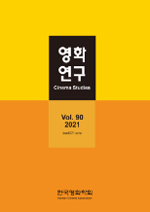- 영문명
- The Emergency Cinema by Abounaddara: Analysis o f the Three Types o f Emergency Cinema and Major Works
- 발행기관
- 한국영화학회
- 저자명
- 이도훈
- 간행물 정보
- 『영화연구』제90호, 37~70쪽, 전체 34쪽
- 주제분류
- 예술체육 > 예술일반
- 파일형태
- 발행일자
- 2021.12.31

국문 초록
이 연구는 시리아의 혁명과 내전 기간 동안 대안적인 영화 만들기를 실천했던아보우나따라의 주요 작품을 유형화하고 분석한다. 아보우나따라는 2010년 시리아의 다마스쿠스에서 익명의 영화인들이 만든 단체로, 그들은 2011년 시리아에서민중 봉기가 일어난 이후 자신들 스스로 긴급영화라고 부르는 작품을 제작해서인터넷을 통해 공개했다. 그들은 주류 미디어가 시리아를 왜곡된 방식으로 재현 하는 과정에서 시리아인의 존엄성이 훼손되고 있다는 것을 지적하면서, 시리아인을 위한 ‘이미지에 대한 권리’를 보장해야 한다고 주장했다. 아보우나따라의 공식비메오 계정에 업로드된 약 450개의 게시물을 검토한 결과 아보우나따라의 작품은 크게 실험적인 다큐멘터리, 인터뷰 다큐멘터리, 일상을 기록한 다큐멘터리로구분할 수 있었다. 실험적인 다큐멘터리는 몽타주, 파운드 푸티지, 자막 등을 활용하여 정치적인 비판과 풍자가 담긴 메시지를 만들어낸다. 인터뷰 다큐멘터리는시리아 혁명과 내전에 참여한 다양한 사람들의 증언을 바탕으로, 혁명, 여성, 고문, 학살, 난민, IS, 어린이, 가난, 죽음 등을 다룬다. 마지막으로, 일상을 기록한다큐멘터리는 관찰자적인 시선으로 시리인의 삶을 포착함으로써 시리아의 미시사를 구축한다. 이 세 유형의 작업들은 시리아의 이미지가 제작, 유통, 상영되는과정에서 불거질 수 있는 일련의 윤리적인 문제를 개선하기 위한 시도였다. 아보우나따라의 긴급영화는 내전이라는 위기 속에서 시리아인들이 잃어버린 삶에 대한 권리와 이미지에 대한 권리를 되찾기 위한 급진적인 영화 운동이었다.
영문 초록
This study categorizes and analyzes the major works of Abounaddara, who practiced making alternative films during the Syrian Revolution and civil war. Abounaddara is an collective created by anonymous filmmakers in Damascus, Syria, in 2010, and they have produced and released works they call themselves emergency cinema since the Syrian people’s uprising. They criticized the mainstream media’s reproduction of Syria in a distorted way, claiming the right to image to protect the dignity of the Syrian. As a result of reviewing about 450 posts uploaded to Abounaddara’s official Vimeo account, Abounaddara’s works could be largely divided into experimental documentary, interview documentary, and documentary that record daily life. Experimental documentary uses montage, found footage, subtitles, etc. to create messages containing political criticism and satire. The interview documentary deals with revolution, women, torture, slaughter, refugees, IS, children, poverty, and death based on the testimony of various people who participated in the Syrian civil war. Finally, a documentary recording daily life builds a microhistory of Syria by capturing it with an observer’s gaze. These three types of work were attempts to formally and content improve ethical problems that could arise during the production, distribution, and screening of Syrian images. Abounaddara’s emergency cinema was a radical film movement to restore the rights to life and the right to image lost by Syrians amid the crisis of civil war.
목차
1. 들어가는 말
2. 긴급영화와 이미지에 대한 권리
3. 저항적 메시지와 일상의 회복
4. 나오는 말
키워드
해당간행물 수록 논문
참고문헌
최근 이용한 논문
교보eBook 첫 방문을 환영 합니다!

신규가입 혜택 지급이 완료 되었습니다.
바로 사용 가능한 교보e캐시 1,000원 (유효기간 7일)
지금 바로 교보eBook의 다양한 콘텐츠를 이용해 보세요!



